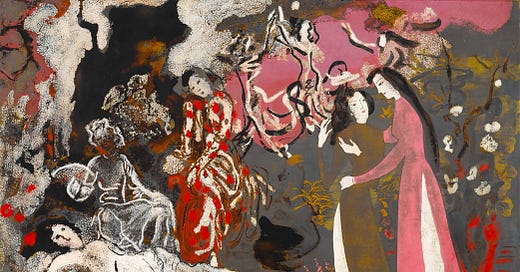Welcome to Vignettes, our weekly cabinet of curiosities. It’s part of our new expanded offerings. Here you’ll find unexpected facts, intimate portraits of interesting people, interviews and more.
Vignettes is for paid subscribers—thank you for your support! If you’re not yet a paid subscriber, what are you waiting for?
For centuries, literature has reflected and shaped how societies view women—and in Vietnam, as is the case in many countries around the world, these portrayals have shifted dramatically across time. Nguyễn Nguyệt Cầm takes us through the journey of women’s roles and portrayals in Vietnamese literature throughout history. From the controversial 19th century poetess Hồ Xuân Hương whose writing style challenged patriarchal norms to the diverging representation of women after the start of the “so-called Vietnam War,” as Cầm refers to it.
Se souvenir des belles choses (Beautiful Memories). 1960. Painting by Nguyễn Gia Trí.
Representations of Vietnamese women in the West are dominated by a handful of remarkably narrow stereotypes in which female characters are defined almost exclusively in relation to Western men. Vietnam war movies almost always feature poor and uneducated sex workers from the southern Republic of Vietnam servicing US soldiers. A different but related kind of stock figure is the courageous and self-sacrificing Vietnamese communist guerilla girl who kills American infantrymen at the end of Full Metal Jacket. Once again, the presence of Western men in this narrative endows the only major female Vietnamese character with her distinctive identity.
Keep reading with a 7-day free trial
Subscribe to Stranger's Guide to keep reading this post and get 7 days of free access to the full post archives.




